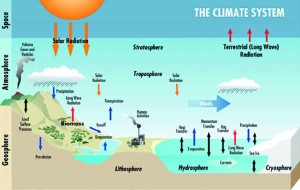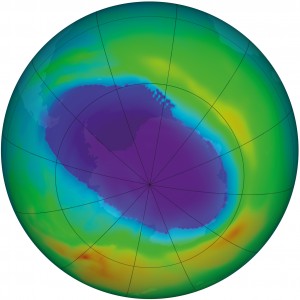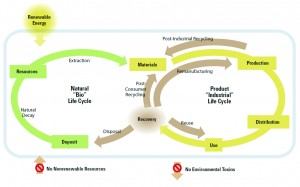Environmental protection
But we must not simply wait and see what happens or hope for high-tech geo-engineering solutions. We must act now, in large ways and in small. We must work together to stop global warming and the climate change it threatens to bring.
The only way to do this is to pursue consistent environmental protection which attempts to minimize environmental damage in all areas. That is why the environmental movements and organizations, which together will lead to concrete environmental policy, are so important.
These movements only began to emerge around 1970, when acid rain and the dramatic deterioration of forests, coral and fish populations brought environmental concerns into the public consciousness, as the Chernobyl explosion in 1986 did for the dangers of atomic power.
But these groups and their influence have waned recently because the majority of people, in order to avoid limiting themselves, remain silent and act as though nothing were wrong.
What can we do?
Our Western living standard is influenced decisively by consumer goods (industrially manufactured products and packaging made of a wide variety of raw materials) whose production requires a great deal of energy and a high and globally increasing volume of traffic. These developments must be put on ecologically sustainable trajectories as quickly as possible.
But all our technological achievements appear to be powerless or, worse, the source of the problem. Twenty years of high industrial and digital technology has nearly done the world in. “Artificial intelligence” increasingly controls the economy, science and politics and even, through computers and mobile devices, each person individually.
It appears that mankind has stopped thinking for itself and lost touch with the meaning of life and its relationship to the Earth, which is its basis for existence. It is basking in a dangerously false sense of security.
That is why we must act at all levels simultaneously in order to avoid the horrible consequences of climate change.
We already have more than enough material reasons to act sustainably, at long last, in a way that will allow us to survive and thrive.
There is also a further reason — a metaphysical one: the turning point and the elevation of the universe into higher bands of vibration will continue until around 2024. That is why it is critical that we actively and intensively use the next ten years to reduce the burden on, and damage to, Mother Earth, otherwise she will be unable to carry us through this turning point into the new age.
What each individual can do
We should show Mother Earth and life respect and love and relieve pressure on them permanently.
There are seven points that are simple and yet comprehensive. If everyone would observe them, we would not only prevent climate change, but also live in love and reverence for GAIA and the divine creation:
– I use my market power by purchasing food and consumer goods more conscientiously, ensuring that they were biologically or ecologically produced.
– I care for Mother Earth by not throwing away anything that does not belong in nature and separate and recycle my trash.
– I show consideration for the resources and cycles of the Earth and, by conscious usage, avoid wasting water or energy.
– I complete local trips on foot or bicycle. For slightly longer trips, I use public transportation and use a car only for long, individual trips (if possible, taking passengers in a vehicle with low CO2 emissions — a hybrid, if possible).
– I respect others and accord them the same rights and duties that I have. Together, we can achieve great things and allow our children to survive.
– I respect the lives of all animals — they are living beings in the divine creation and have the right to living space. I will therefore continuously reduce my consumption of meat.
– I also respect plants as living beings that have sensibilities and feel whatever consciousness we direct towards them.
What households can do
Market power
Households, including families, cohabitation and single persons can also exert their primary influence as market actors. They can also engage in simple but effective behavior to counter climate change:
Garbage disposal
– Separate garbage and recycle.
– Avoid using plastic bags.
– Use biodegradable cleaning agents (for dishes, clothes and living areas)
Energy
– Use renewable energies and switch to energy providers who are a bit more expensive but provide power that comes from renewable sources (solar, wind and water).
– Install heat pumps instead of heating systems that burn oil or gas.
– When looking for a new rental property, pay attention to the heating system
Traffic
– Fewer cars per family (car sharing).
– Switch to a hybrid or an electric automobile
Nutrition and water
– Reducing consumption of meat and ultimately becoming vegetarian enhances the health of both your own body and of GAIA in the long term
– As we have seen, the inhumane industrial livestock farming has the largest influence on the environment. It produces more carbon dioxide, methane and nitrous oxide than either all of transportation or energy generation.
– At the same time, animal feed consumes one third of the world’s crop yields. The worldwide food and water shortage could be solved within ten years if everyone refrained from eating meat.
What countries and the UN can do
Countries
Countries should:
– Rethink energy policy and put their programs on track for complete adoption of renewable energies.
– Abandon dangerous nuclear energy and dirty coal-powered energy.
– Review national laws and adopt environmental protection legislation before the international community does (Germany and Switzerland have done an excellent job of modeling this behavior).
– Ban speculation on grain harvests, food and meat
International communities and the UN Climate Summit
The United Nations have the responsibility for international climate policy and with the UN Climate Summit, also possess a platform that would allow them to fulfill that responsibility. However, we need a Climate Summit that is worthy of this title. It all started so promisingly:
– In 1992, the United Nations Conference on Environment and Development in Rio de Janeiro ended with Agenda 21 as a framework convention for environmental protection, making it the first international treaty to address climate change as a serious problem and commit the international community to action. This agenda came into force in 1994.
-> A list of all the Earth Summit and its results can be found in the book GAIA LEGACY or in e-book
– the 20th CMP will take place in Lima in 2014 with the goal of replacing the Kyoto Protocol with a globally binding climate agreement.
But I fear that we already know what the result will be: much talk and little action.
It is a tragedy for Mother Earth and mankind: 21 years have passed since Agenda 21 in Rio and we have achieved nothing but documented consensus on declarations of intent. But these declarations are neither accepted by the biggest offenders nor observed by most states even though the papers indicate that global emissions are to reach their highest point by 2015 and ought to fall to around zero by the end of the century. Such goals will be impossible to reach if things continue like this.
Note:
Extrapolations show that climate change will cost up to $800 billion in 2100, which is simply wasted state funds. Environmental protection is also expensive, but it would still be much more cost-effective and not only prevent climate change but also give future generations a new perspective at the same time.
Measures
The international community must act now by means of clear climate targets that are adhered to no matter how much effort they require.
– International treaties and measures against global warming.
– These should provide the groundwork for clear laws that are strictly enforced.
– Specify energy policy and transition the nations into renewable energies with rewards for active countries and penalties for passive ones.
– Introduce and regulate emissions trading and so that nations that over-emit must pay or purchase credits from countries with low emissions.
This must include the circle of the worst offenders, their main emissions and necessary laws and measures in those countries.
Industry
– Main emission: Carbon dioxide (CO2).
– Measures: Establish reduction goals for CO2 emissions with a second Kyoto Protocol.
– Establish emission credit trade.
Power plants, primarily coal and gas-driven facilities
– Main emission: Sulfur dioxide (SO2).
– Measures: Establish reduction goals for SO2 emissions with flue-gas desulfurization. Ban coal-fired power plants and gradually shut existing ones down.
– This measure was actually agreed upon in 2010, but since a few European countries have turned their backs on nuclear energy, coal has received a new lease of life. It is bad enough that China and Russia are investing so heavily in cheap coal.
Animal husbandry
– Main emission: Carbon dioxide (CO2), methane (CH4) and ammonia (NH3).
– Measures: Call for meatless days (the Greens can take this role in Germany).
– Reduce NH3 emissions through the Convention on Long-Range Trans boundary Air Pollution and other measures.
Traffic
– Main emission: Nitrogen oxides (NOx), CO2.
– Measures: Reduce NOx emissions by establishing exhaust norms and installing three-way catalytic converters.
– Steering tax. Support of vehicles with hybrid and electrical engines.
Ship traffic
– Main emission: (NOx), (SO2), fine particulates.
– Measures: Immediate introduction of filter systems for all large ship engines.
– Global ban and penalties for dumping at sea.
– Dramatic price increase for the dirty HFO — since 2008, toxin emission has already decreased because of the slightly higher fuel prices and the slow steaming that resulted from it.
Air traffic
– Main emission: Carbon dioxide (CO2).
– Measures: Stricter exhaust regulations for aircraft manufacturers.
– End preferential taxation policies and tax kerosene like other fuels are taxed.
What can science do?
First, a truly heretical question to think about:
“Does science do any good for people?”
(J. Robert Oppenheimer, inventor of the atomic bomb)
Yes, science has largely been good for people to the extent that it truly creates knowledge and recognizes that it is always the image of the current state of research, but not as a final insight or truth. And if it is not corrupted by business and politics (as was the case with Mr. Oppenheimer). Science should always serve insight and improvement in living conditions.
Research has contributed to our understanding of climate change, the ecological systems and economic and production processes, winning over not only the general population but the leadership of major companies to the idea of bringing our behavior back into harmony with nature and the Earth. More and more scientists should also have the courage to appear in public and share their insights with the public in simple, understandable language (avoiding overly technical expressions). I continue to wonder where they all are and why they don’t emerge from their laboratories and make their contribution to enlightenment. They are rarely heard except in technical scientific forums and publications. They appear only very rarely in the mass media of newspapers, radio and television unless they have just won a Nobel Prize. I hope very much that this will soon change; their influence would be great…
The example of chlorofluorocarbons
After the ozone hole was discovered in 1980 and the rapidity of its growth was observed, researchers traced the cause back unambiguously to chlorofluorocarbons. Trade with these substances was banned globally within seven years in the 1987 Montreal Protocol, a high point in the environmental movement. It is an excellent example of how sensible research can change and even save the world. It is also evidence of how decisively international communities can act when they really want to and do not allow themselves to be bought off or held up by lobbyists from the multinational corporations. Why is action against greenhouse gases not being taken just as quickly and consequentially?
What business and industry can do
Business and industry have played key roles in the creation of the problem, but will be just as essential for their solution. Let us hope that their conscientiousness and our market pressure will move them to assume their responsibility and not sacrifice our world to corporate profits.
Energy
– Convert to renewable energies.
– Forego nuclear and coal-fired energy; these two measures would reduce the two largest global dangers.
– Generate energy through energy recovery and solar panels on rooftops.
Production
– Filtration plants for production machines
– Transition to more natural and biodegradable production materials.
– Recycle waste instead of burning it.
Cradle-to-cradle production
This simple, logical concept was developed by Michael Braungart and William McDonough in 2002 and published in the book “Cradle to Cradle, Remaking the Way We Make Things”.
The “cradle to cradle” strategy is based on a cyclical use of resources in which production methods are focused on the preservation of materials and energies generated and on ethical values.
The natural food cycles serve as a model: one organism’s waste is always used or consumed by another. The material flows in production should be planned in the same way so that waste materials and inefficient use of energy is prevented. The materials used are thus placed in a closed cycle and no natural resources are lost.
The implementation of this method in production would mean very little or no garbage; any waste would be recycled to avoid negative influences on the environment.
This neutral ecological balance on the “cradle-to-cradle” bases (as opposed to “cradle-to-grave”) — through complete recycling of raw materials and energy — can be reached by observation of the “7Rs Golden Rule”:
– reduction
– reusing
– recycling
– recovering
– rethinking
– renovation
– regulation
The UN should declare this production model a global standard.
This is just a small excerpt from the book GAIA LEGACY.




